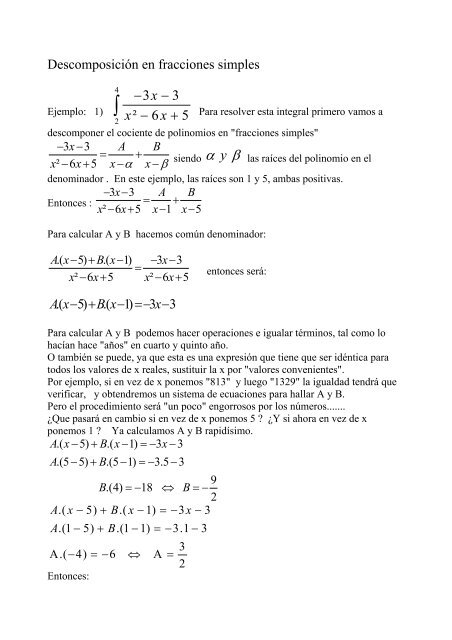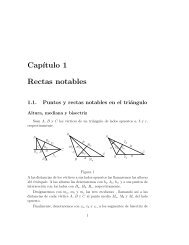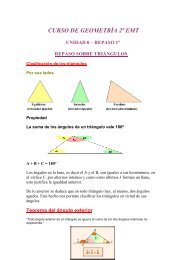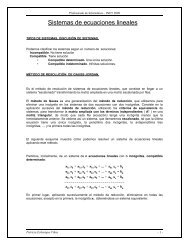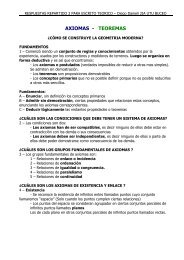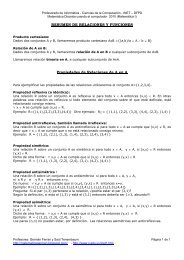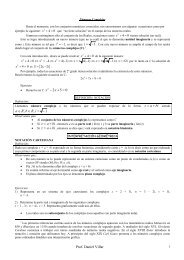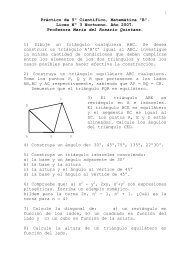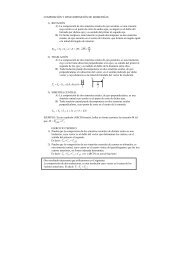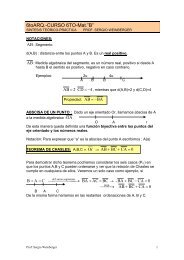Descomposición en fracciones simples: ejemplos 1
Descomposición en fracciones simples: ejemplos 1
Descomposición en fracciones simples: ejemplos 1
Create successful ePaper yourself
Turn your PDF publications into a flip-book with our unique Google optimized e-Paper software.
<strong>Descomposición</strong> <strong>en</strong> <strong>fracciones</strong> <strong>simples</strong><br />
Ejemplo: 1)<br />
4<br />
2<br />
−3x−3 x² − 6x + 5<br />
∫ Para resolver esta integral primero vamos a<br />
descomponer el coci<strong>en</strong>te de polinomios <strong>en</strong> "<strong>fracciones</strong> <strong>simples</strong>"<br />
−3x−3 A B<br />
= +<br />
x² − 6x+ 5 x−αx− β<br />
si<strong>en</strong>do<br />
α y β las raíces del polinomio <strong>en</strong> el<br />
d<strong>en</strong>ominador . En este ejemplo, las raíces son 1 y 5, ambas positivas.<br />
−3x−3 A B<br />
Entonces : = +<br />
x² − 6x+ 5 x−1 x−<br />
5<br />
Para calcular A y B hacemos común d<strong>en</strong>ominador:<br />
Ax .( − 5) + Bx .( −1) −3x−3 =<br />
x² − 6x+ 5 x² − 6x+ 5<br />
A.( x− 5) + B.( x− 1) =−3x− 3<br />
<strong>en</strong>tonces será:<br />
Para calcular A y B podemos hacer operaciones e igualar términos, tal como lo<br />
hacían hace "años" <strong>en</strong> cuarto y quinto año.<br />
O también se puede, ya que esta es una expresión que ti<strong>en</strong>e que ser idéntica para<br />
todos los valores de x reales, sustituir la x por "valores conv<strong>en</strong>i<strong>en</strong>tes".<br />
Por ejemplo, si <strong>en</strong> vez de x ponemos "813" y luego "1329" la igualdad t<strong>en</strong>drá que<br />
verificar, y obt<strong>en</strong>dremos un sistema de ecuaciones para hallar A y B.<br />
Pero el procedimi<strong>en</strong>to será "un poco" <strong>en</strong>gorrosos por los números.......<br />
¿Que pasará <strong>en</strong> cambio si <strong>en</strong> vez de x ponemos 5 ? ¿Y si ahora <strong>en</strong> vez de x<br />
ponemos 1 ? Ya calculamos A y B rapidísimo.<br />
A.( x− 5) + B.( x− 1) =−3x−3 A.(5− 5) + B.(5−<br />
1) =−3.5−3 9<br />
B.(4) =−18 ⇔ B=−<br />
2<br />
A.( x − 5) + B.( x − 1) = −3x − 3<br />
A.(1− 5) + B.(1−<br />
1) = −3.1− 3<br />
3<br />
A.( − 4) = −6 ⇔ A =<br />
2<br />
Entonces:
4 4<br />
−3x−3 ⎛3/2 −9/2⎞<br />
⎛3 9 ⎞<br />
= ⎜ + ⎟= ⎜ . Lx−1 − . Lx−5⎟<br />
x² − 6x+ 5 ⎝x−1 x−5⎠<br />
⎝2 2 ⎠<br />
∫ ∫<br />
2 2 2<br />
Terminando:<br />
⎛3 9 ⎞ ⎛3 9 ⎞<br />
⎜ . L4−− 1 . L4−5 ⎟−⎜ . L2−− 1 . L2−<br />
5⎟=<br />
⎝2 2 ⎠ ⎝2 2 ⎠<br />
⎛3 9 ⎞ ⎛3 9 ⎞<br />
⎜ .3 L − .1 L⎟−⎜ .1 L − .3 L ⎟=<br />
63 L<br />
⎝2 2 ⎠ ⎝2 2 ⎠<br />
7<br />
5<br />
∫ 2<br />
Para descomponer el integrando <strong>en</strong><br />
Ejemplo 2)<br />
3 ( )<br />
x − 2 .( x − 1)<br />
<strong>fracciones</strong> <strong>simples</strong>, hay que usar el d<strong>en</strong>ominador (x-2) y también el (x-2)².<br />
Y ahora vi<strong>en</strong>e el común d<strong>en</strong>ominador:<br />
A B C A.( x−2)( x− 1) + B.( x− 1) + Cx ( −2)<br />
+ + =<br />
2 2<br />
x−2 ( x−1) ( x−1)( x−2)<br />
( x−<br />
2)<br />
Ax .( −2)( x− 1) + Bx .( − 1) + Cx ( − 2) = 5<br />
2<br />
Entonces queda:<br />
Sustituimos la x por 1, 2 y por otro número cualquiera que nos hagan las<br />
operaciones s<strong>en</strong>cillas, por ejemplo 0.<br />
Con esto el tema NO está terminado. Más bi<strong>en</strong> recién ahora pued<strong>en</strong> empezar a<br />
<strong>en</strong>t<strong>en</strong>der algo y empezar a estudiar <strong>en</strong> libros.<br />
Esto recién comi<strong>en</strong>za......Chau. Prof. Saúl T<strong>en</strong><strong>en</strong>baum<br />
4<br />
2


